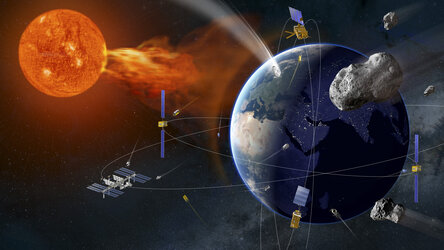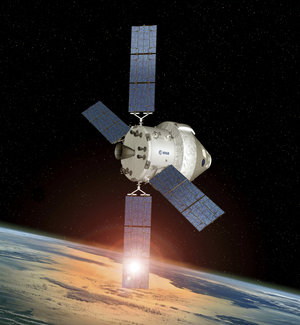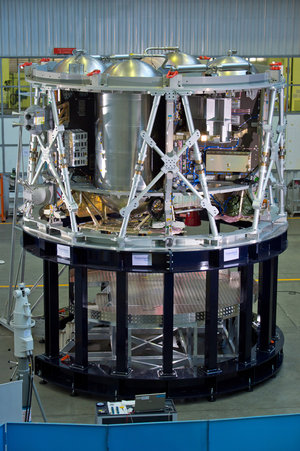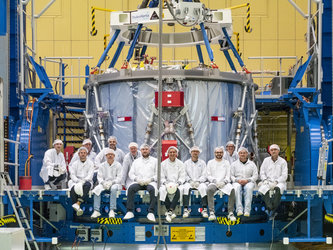Artemis IV
In brief
The Artemis IV mission is the fourth planned mission of the Artemis programme and will see two astronauts land on the Moon as well as deliver the first ESA module for the Gateway: I-Hab.
In-depth

The launch will be on a Space Launch System rocket from the usual Launchpad 39B at NASA’s Kennedy Space Center in Florida, USA. The mega Moon rocket will propel four astronauts inside Orion to the Moon but Artemis IV will be the first mission to use a new second stage, replacing the interim cryogenic propulsion stage used on the first three Artemis missions. The advanced exploration upper stage booster increases the SLS’s rocket’s capability from 27 to 42 tonnes, allowing for more hardware to be sent to the Moon with the Orion spacecraft.

The extra boost is necessary to bring ESA’s Lunar I-Hab to the lunar Gateway, which will serve as the primary habitat module of the lunar station.
Once the exploration upper stage has finished its boost to the Moon, Orion will detach from the second stage and the European Service Module will use its 24 reaction control thruster engines to turn itself around and return to the Lunar I-Hab that flew to space under a separate compartment of the SLS rocket fairing. Orion will then attach itself to Lunar I-Hab, pull it away from the second stage and tug it to the Gateway on its four-day journey to the lunar Gateway’s orbit.
Orion and the European Service Module will tug the module into position around the Moon and dock with the Gateway, pushing Lunar I-Hab into position. Lunar I-Hab will feature four docking ports, two radial ports for a cargo and a lunar lander vehicle and two axial ports for connection to other lunar gateway elements.
Second Artemis Moon landing

Part of the Artemis IV mission will see two astronauts leave Gateway and descend to the Moon for a stay on the lunar surface – the second Moon landing for Artemis.
While two astronauts stay on the Gateway and continue setting up Lunar I-Hab, two Artemis colleagues will transfer to a human landing system that will undock from the Gateway and land on the Moon. During a complete orbit of Orion and Gateway, the two moonwalkers will conduct science on the Moon and return to Gateway six days later.
Return home

Once reunited, the astronauts will have up to five days in orbit to transfer supplies and samples from the human landing system to Orion for the return home.
When ready and the hatches are closed, the European Service Module will gently pull Orion away from the Gateway and start its voyage back to Earth. Much like in the Artemis III mission, Orion will get a gravity assist from the Moon, with the European Service Module’s main engine firing to boost itself around the Moon and onwards to Earth.
Approaching Earth from the south reentry into Earth’s atmosphere will see Orion arrive at speeds of about 40 000 km/h. Less than an hour before touchdown the European Service Module will say farewell to the Orion Crew Capsule and together with the Crew Module Adapter the expendable parts of Orion will burn up harmlessly over uninhabited parts of Earth.
Our atmosphere and 11 parachutes will reduce the spacecraft’s speed for a splashdown in the Pacific Ocean.
Technical details

Launch: 2027
Duration: 3-4 weeks
Launch Mass
- Launch mass of European Service Module: 13 500 kg
- 8600 kg of propellant
- 240 kg of drinking water
- 30 kg of nitrogen
- 90 kg of oxygen
- Total Orion launch mass: over 20 tonnes
- Orion payload volume up to 0.57 m3
- Orion payload mass up to 380 kg
- Lunar I-Hab module
- Pressurised volume: 36 m3
- Habitable volume: 10 m3
- Maximum launch mass: 10 000 kg
Artemis IV step by step:

- Launch by Space Launch System from pad 39B at NASA’s Kennedy Space Center, USA
- Mission control perform final checks in low-Earth orbit
- Translunar injection by exploration upper stage (EUS)
- Transposition manoeuvre : Orion separates from EUS, turns around, docks with Lunar I-Hab and extracts it from EUS
- Orion and European Service Module take Lunar I-Hab to the Moon
- Flyby of the Moon with gravity assist
- Arrival at Near Rectilinear Halo Orbit
- Docking with Gateway and connection of Lunar I-Hab to Gateway
- Transfer of equipment and astronauts
- Install and activate Lunar I-Hab as part of Gateway
- Prepare lunar lander for departure to Moon
- Undocking of human landing system with two astronauts for lunar sortie
- Orion does six-day complete orbit of Moon while docked to the Gateway as two astronauts work and explore the lunar South Pole.
- Liftoff of human landing system from the Moon
- Human landing system docks with Gateway
- Transfer of supplies and setup for home trip to Earth
- Orion undocks from Gateway with all four astronauts
- Departure from Near Rectilinear Halo Orbit
- Main engine fires for lunar gravity assist back to Earth
- Homeward cruise
- Separation of the Crew Module from the expendable elements of Orion (the European Service Module and the Crew Module Adapter)
- Reentry of the Crew Module and splashdown in the Pacific Ocean















 Germany
Germany
 Austria
Austria
 Belgium
Belgium
 Denmark
Denmark
 Spain
Spain
 Estonia
Estonia
 Finland
Finland
 France
France
 Greece
Greece
 Hungary
Hungary
 Ireland
Ireland
 Italy
Italy
 Luxembourg
Luxembourg
 Norway
Norway
 The Netherlands
The Netherlands
 Poland
Poland
 Portugal
Portugal
 Czechia
Czechia
 Romania
Romania
 United Kingdom
United Kingdom
 Slovenia
Slovenia
 Sweden
Sweden
 Switzerland
Switzerland















































